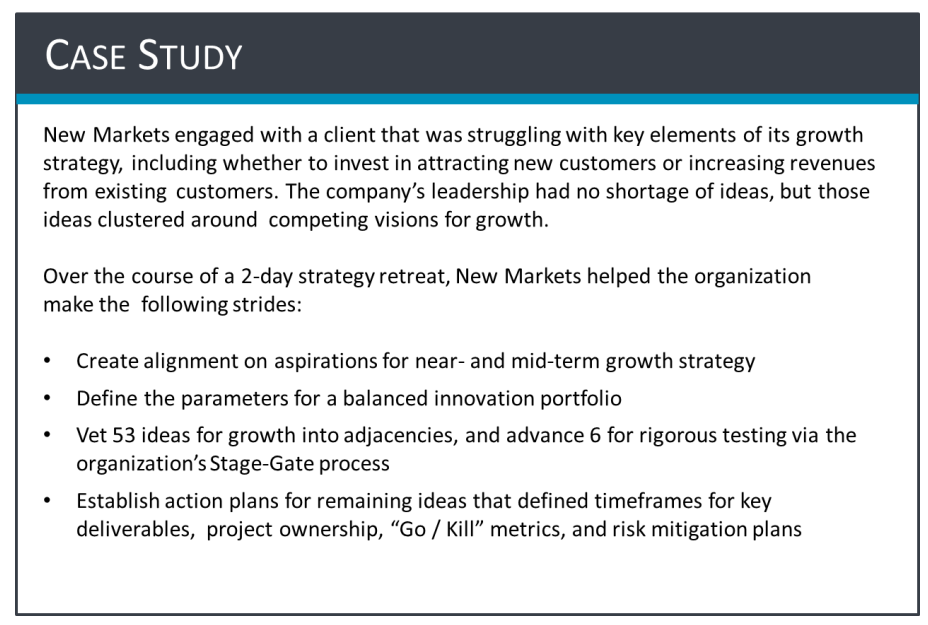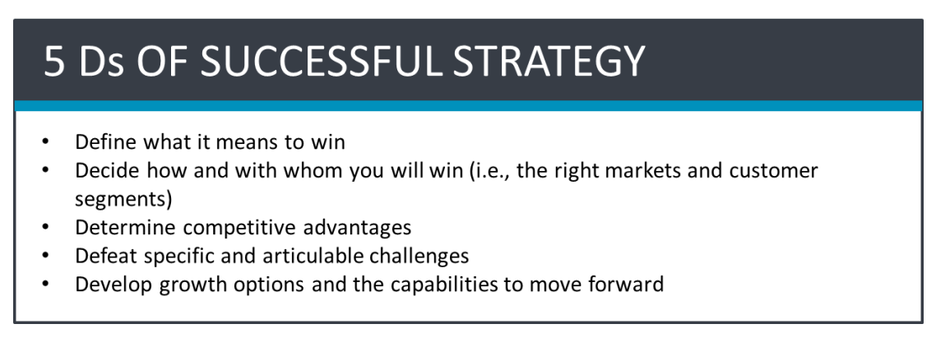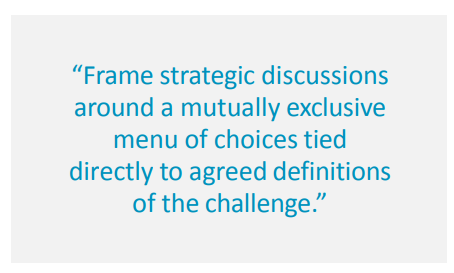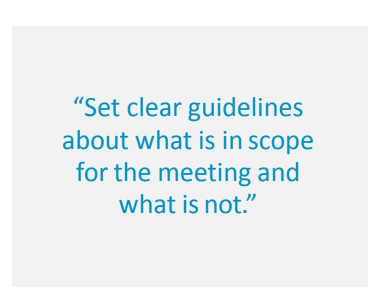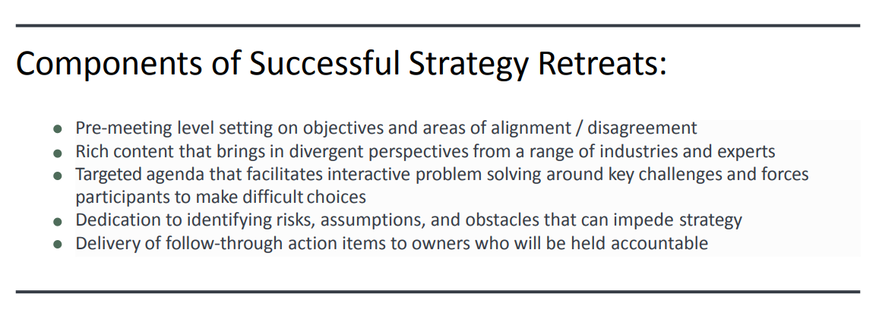|
WORKING PAPER
Strategic Planning in Times of Uncertainty |
|
Executive Summary
Traditional approaches to strategic planning are unsuited to increasingly volatile business environments. They ignore uncertainty about future conditions, gloss over the diverging views of stakeholders, and frequently avoid the need to make hard choices. The direction they provide is often as vague as it is illusory. Yet companies that are thriving in turbulent conditions show how distinct approaches can yield better results. They consciously consider a variety of scenarios, account for opposing viewpoints, force difficult decisions, and look dispassionately at both new types of threats and emerging opportunities.
THE NECESSITY AND DANGER OF STRATEGIC PLANS
While the circumstances surrounding strategic planning change at ever-increasing speed, corporate approaches to strategy making have not. This mismatch creates vulnerabilities. The trend lines, market sizing, and competitive benchmarks that served companies well during periods of gradual market evolution do little good in industries where business models are changing, disruptive technologies are rising, and rivals are emerging from unexpected directions. Faced with such turbulence, many pundits who have not lived in the trenches advise companies to focus on being agile and to avoid complex business plans. Unfortunately, executives often do not have that option. Leaving aside the fact that the corporate hierarchy may require these documents, countless industries are based upon long-term thinking. It takes years to develop complicated devices, build brands, or construct branch networks. Agility is a virtue, but – as with many virtues – it is often more feasible in theory than in practice.
Traditional approaches to strategic planning are unsuited to increasingly volatile business environments. They ignore uncertainty about future conditions, gloss over the diverging views of stakeholders, and frequently avoid the need to make hard choices. The direction they provide is often as vague as it is illusory. Yet companies that are thriving in turbulent conditions show how distinct approaches can yield better results. They consciously consider a variety of scenarios, account for opposing viewpoints, force difficult decisions, and look dispassionately at both new types of threats and emerging opportunities.
THE NECESSITY AND DANGER OF STRATEGIC PLANS
While the circumstances surrounding strategic planning change at ever-increasing speed, corporate approaches to strategy making have not. This mismatch creates vulnerabilities. The trend lines, market sizing, and competitive benchmarks that served companies well during periods of gradual market evolution do little good in industries where business models are changing, disruptive technologies are rising, and rivals are emerging from unexpected directions. Faced with such turbulence, many pundits who have not lived in the trenches advise companies to focus on being agile and to avoid complex business plans. Unfortunately, executives often do not have that option. Leaving aside the fact that the corporate hierarchy may require these documents, countless industries are based upon long-term thinking. It takes years to develop complicated devices, build brands, or construct branch networks. Agility is a virtue, but – as with many virtues – it is often more feasible in theory than in practice.

Other pundits counsel that companies should simply set a plan and stick with it. But that approach turned out poorly for Circuit City, Dell, Fannie Mae, and many others that these writers formerly praised for this approach. Given the volatility in business today, conditions do not provide the luxury of easily-predicted future circumstances. Strategic plans that fail to account for uncertainty and change can become dangerous documents. They tend to give a false sense of certainty about the future and restrict the frame of reference when making key decisions. Such plans often divert attention from executives’ diverging beliefs about a business, and instead focus thoughts on a tightly-bounded, blinkered view that fits neatly into PowerPoint slides. They may paper over major issues by directing a company toward a laundry list of strategic “priorities” that spread staff too thinly and guarantee that the company executes very few things well.
Good strategic planning approaches – and the roadmaps that come out of them– devote substantial amounts of time to contemplating the unknown. Not only do they identify major risks, assumptions, and uncertainties, but they chart a path for overcoming those barriers, leaving room for course correction as the future becomes clear. Importantly, these sessions also help executives to decide what capabilities need to be built or developed to meet emerging trends and new industry patterns. Whether it means designing an incubator to fast-track high-potential ideas or deepening investment in important core assets, leaders should leave strategic planning sessions with a strong understanding of the underlying infrastructure that will need to be in place to support the sexier initiatives that come out of the session.
HAZARDS OF STRATEGIC PLANNING IN UNCERTAINTY
Evidence of rising turbulence is everywhere. Going beyond the froth of everyday headlines, there is robust data indicating an accelerating rate of change:
HAZARDS OF STRATEGIC PLANNING IN UNCERTAINTY
Evidence of rising turbulence is everywhere. Going beyond the froth of everyday headlines, there is robust data indicating an accelerating rate of change:
- The time an average company spends on the S&P Index has fallen from 90 years in the 1930s to under 25 years today
- The chance of an industry leader being relegated to second-tier status has tripled since the 1970s
- In the first part of the 20th century, technological innovations took 60 years to diffuse globally. Recently the figure has fallen to under 16 years
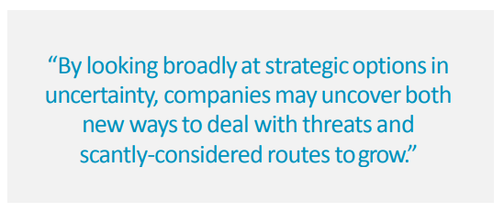
Discontinuities – in technology, business models, competitive sets, customer needs, and much else – create both threat and opportunity. Companies often grasp the threat, as declining prices and customer defections mark the clear erosion of old success formulas. The opportunity created by change may be less visible.
Frequently the seeds of new markets are so tiny as to be unnoticed by big companies, and they may get their start with neglected customer types or in fields broadly ignored by the big incumbents. To take just one example, in 1980 AT&T passed on entering the cellphone industry after estimating that at the turn of the millennium the total number of handsets in use worldwide would be 900,000 (they were off by 750 million).
AT&T’s experience is far from a unique case. Nearly one-fifth of U.S. economic growth over the past two decades has stemmed from totally new industries. Another big chunk comes from new segments of existing industries. After stripping away these inherently turbulent sources of industry change, the remainder of economic growth looks paltry. By looking broadly at strategic options during uncertainty, companies may uncover both new ways to deal with threats and scantly-considered routes to grow. The company may not be able to follow up on each avenue, but a clear-eyed look at the environment and options ensures that the company drives into the foggy future with its headlights blazing as brightly as possible.
New Markets’ experience with strategic planning points to four additional, and often overlooked, pitfalls to avoid:
1. Fuzzy Objectives
Why are you writing a strategic plan? Is it to argue for resources, allocate budgets, create performance metrics, decide among customer targets, or other reasons? If you lack a detailed view of what choices the strategic plan will inform, the document may not provide clear guidance when those calls need to get made. Equally, it will be too easy to cut and paste templates from previous years' plans when the real need is for fresh thinking to underpin big decisions. Strategic plans are usually best when they focus their attention on a handful of critical issues, not when they churn out a list of 20 must-do's that could have been written in any year, for any competitor.
2. No Scenarios
When surrounded by volatility, it is convenient to choose one consensus view of the future and to create plans accordingly. This is hazardous. If companies do not clearly map out alternative scenarios, they can be unwittingly blind to how surprises may upend carefully laid strategies. Have a set of scenarios to evaluate, and consider placing a small number of bets to exploit seemingly unlikely scenarios should they come to pass.
3. Too Many People
If a strategic plan needs to finely calibrate the moves of loosely-controlled business units, and if achieving consensus is vital to the plan's effective implementation, then it makes sense to include a wide range of stakeholders in the discussions. However, in turbulent times this is dysfunctional. Industry upheaval often calls for tough choices, and consensus will not be possible. Pretending that a process will gain alignment simply invites passive-aggressive behavior, with participants feigning assent while they try to undermine key decisions behind the scenes. The result may be a messy compromise that fails to provide the organization with the focus required. In times of major uncertainty, seek input from many sources, but keep the most important meetings small.
4. Too Rushed
Faced with a fire hose of challenges, many businesses in turbulent industries conclude they can dedicate only one day to strategic issues. That is a big problem. It is not necessary to spend several days in a far-off location, but the process will be far more effective if it is staged over the course of three to four offsite meetings. Big decisions have to be framed, then informed by data, then thought through for execution. Clustering these steps into one meeting risks neglecting key details, or biasing discussions toward issues where data is readily at hand. Moreover, the flipside of small meetings is a need for attendees to gather input and gauge the reactions of people outside the room. Staging a handful of meetings over 4-8 weeks allows ideas to percolate, reality checks to occur, and the appropriate research to take place.
SUCCESSFUL PLANNING IN UNCERTAINTY
Companies that have successfully traveled this road provide a template for how to proceed:
1. Defining Challenges
A frank dialogue about strategy in uncertainty will usually produce a wide a range of opinions. Dig more deeply, and you will find that the diversity of views usually corresponds with how executives frame the problem. Pay attention up front to defining the challenges carefully. Is it decreased willingness to pay, or a change in who makes purchasing decisions? Is it low-end store brands, or the neglect of high-end boutiques that could create new retail outlets? By aligning on the right issues, a team can focus on answering the questions that really matter and avoid meandering discussions.
Faced with a fire hose of challenges, many businesses in turbulent industries conclude they can dedicate only one day to strategic issues. That is a big problem. It is not necessary to spend several days in a far-off location, but the process will be far more effective if it is staged over the course of three to four offsite meetings. Big decisions have to be framed, then informed by data, then thought through for execution. Clustering these steps into one meeting risks neglecting key details, or biasing discussions toward issues where data is readily at hand. Moreover, the flipside of small meetings is a need for attendees to gather input and gauge the reactions of people outside the room. Staging a handful of meetings over 4-8 weeks allows ideas to percolate, reality checks to occur, and the appropriate research to take place.
SUCCESSFUL PLANNING IN UNCERTAINTY
Companies that have successfully traveled this road provide a template for how to proceed:
1. Defining Challenges
A frank dialogue about strategy in uncertainty will usually produce a wide a range of opinions. Dig more deeply, and you will find that the diversity of views usually corresponds with how executives frame the problem. Pay attention up front to defining the challenges carefully. Is it decreased willingness to pay, or a change in who makes purchasing decisions? Is it low-end store brands, or the neglect of high-end boutiques that could create new retail outlets? By aligning on the right issues, a team can focus on answering the questions that really matter and avoid meandering discussions.
|
2. Clear Options
Big companies often avoid making choices. Choice means that someone loses, and that creates political risk. Yet, during industry tumult, muddling through may be impossible. Frame strategic discussions around a mutually exclusive menu of choices tied directly to agreed definitions of the challenge. The leap from present circumstances to the chosen future state does not need to occur overnight, but the destination has to be clear. At the same time, setting up milestones and “kill criteria” helps create faith that bad decisions can be corrected before it is too late. |
3. Stay Humble
In a turbulent environment, you may not even know what you do not know. If you can preserve strategic options through mechanisms such as partnering with outside companies or incubating a handful of new business models, by all means do so. These moves may require scant investment of money and time while providing critical hedges against unexpected changes in the marketplace. Likewise, it is important to avoid falling victim to the fear that uncertainty breeds. Companies often respond by clinging to one of two extremes: returning to a streamlined focus on the core business or placing an excessively large bet on a high-risk initiative. Addressing an unknown future requires maintaining a carefully balanced innovation portfolio that includes projects that are core, adjacent, and transformational.
ORGANIZING A STRATEGY RETREAT
An off-site meeting can significantly aid the making of strategic decisions in uncertainty. Some logistical details are important. The location may be quite mundane, but it should be away from the office to facilitate focus on the big questions. A neutral facilitator – such as a business school professor, respected retiree, or outside advisor – should help the group to concentrate on key issues, surface unpopular points of view, and ask difficult questions. Most critically, the retreat should be embedded in a well-defined process:
1. Before the Meeting
Opinions of meeting participants should be probed in advance to ensure that key issues are addressed and carefully framed. There should be a clear view on what success for the meeting will look like. These interviews also provide an opportunity to discover areas of alignment and disagreement, as well as to pinpoint issues on which debate would be futile. By making these findings ahead of time, valuable off-site time can be saved for addressing more pressing challenges.
|
2. During the Meeting
Although the facilitator will encourage an open, candid discussion, it is equally important to set clear guidelines about what is in scope for the meeting and what is not. Time cannot be wasted rehashing old debates or contemplating unrelated pet projects. To help see issues from multiple viewpoints, however, key leaders should withhold early and vocal judgments, as these views can quickly shut down expansive thinking. Ultimately, one of the most important tasks for the facilitator will be ensuring that the attendees identify critical challenges and make decisions that address those challenges. |
3. After the Meeting
A detailed write-up should capture nuances of the discussion, not just flipchart bullet points. Specific people should be tasked with following up on unresolved issues and be given concrete timelines and deliverables for those assignments. For example, this may involve gathering additional data or running quick prototype-and-learn experiments to test key assumptions. Dates for future meetings should be set well in advance so that there is no option to expand analysis of open issues too far, nor of ducking tough issues through avoiding follow-up discussions. Developing effective strategy in turbulent times requires a small up-front investment in breaking old habits and having difficult discussions. It is worth the inconvenience. A good strategy is most relevant not when you foresee smooth sailing, but when big storms loom directly ahead.
CONCLUSION
Strategic planning is a necessity for companies looking to succeed in the long-term, and it cannot be approached haphazardly. Firms need to understand stakeholders’ ingoing perspectives, enable clear and open dialogue on key issues, and ensure that strategic objectives are obvious to all. Although diverse perspectives are important for developing ideas, the final output will result in difficult choices that foreclose some avenues. At the same time, good strategic plans leave room to learn and adapt in uncertain environments. They identify critical challenges, direct teams’ priorities in meeting them, and lead to follow-up mechanisms that allow for reevaluation. Good strategic plans enable both focus and expansion, addressing threats while also seizing opportunities for the future.
Strategic planning is a necessity for companies looking to succeed in the long-term, and it cannot be approached haphazardly. Firms need to understand stakeholders’ ingoing perspectives, enable clear and open dialogue on key issues, and ensure that strategic objectives are obvious to all. Although diverse perspectives are important for developing ideas, the final output will result in difficult choices that foreclose some avenues. At the same time, good strategic plans leave room to learn and adapt in uncertain environments. They identify critical challenges, direct teams’ priorities in meeting them, and lead to follow-up mechanisms that allow for reevaluation. Good strategic plans enable both focus and expansion, addressing threats while also seizing opportunities for the future.
HEADQUARTERS | 50 FRANKLIN STREET | SECOND FLOOR | BOSTON, MA 02110 | UNITED STATES | TEL. +1 617 936 4035
New Markets Advisors © 2023 - Terms of Use - Privacy Policy

